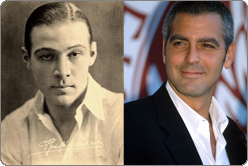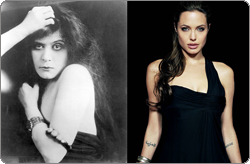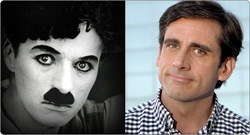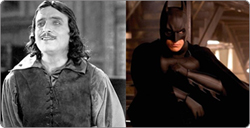Article
A Century of Movies
Written by Eric
First Posted: August 24th, 2007

Hollywood heart throbs then and now: Rudolph Valentino and George Clooney.
Hollywood movies have been around for about 100 years. Each decade of film making seems to be unique. As our world has changed, so has Hollywood's product.
The first movies made for entertainment sake, and not just as a curiosity were around 1908. That is when Max Sennett first starting making films. He would go onto produce many films starring such stars as Fatty Arbuckle, Mabel Normand and Charlie Chaplin. America's sweetheart during the silent film era was Mary Pickford. Her first movie was made in 1909. The movies made in the first 10 years, lets say to 1919 were mostly short films that ran anywhere from 15 to 25 minutes. Often the same sets and locations were used, and if you watch enough of them you start recognizing similar faces. This was Hollywood in it's infancy. They were still perfecting the art of movie making. The movie industry moved from New York to California because of cheaper, larger open spaces and the weather. In those days, lighting was a real problem so they filmed many scenes on sets that did not have roofs so as to take advantage of the sunlight. The lightbulb at that time was only 30 years old.
Cecille B. DeMille directed the very first fulllength movie in Hollywood, The Squaw Man in 1913. The most famous feature length silent film made in the teens was The Birth of a Nation (1915), directed by D.W. Griffith. It runs anywhere between 125 and 190 minutes depending on what version you see. The feature length film really did not hit its stride until around 1919 with movies like Male and Female with Gloria Swanson. The 1920's had such classic feature length silent films as The Mark of Zorro (1920) with Douglas Fairbanks, Rudolph Valentino's The Sheik and Charlie Chaplin's The Kid both made in 1921. There was Buster Keaton in The General and Clara Bow in It both made in 1927. Silent films were reaching a peak when everything came crumbling down with the advent of the talking picture in 1927. The Jazz Singer is not entirely with sound but it contains enough to mark the beginning of a new era.

Hollywood Sex Goddesses then and now: Theda Bara and Angelina Jolie.
The 1930's saw Hollywood with a social conscience. With the stock market crash of 1929 the country became a different place and Hollywood reflected a more realistic world. Gone were the lavish sets and costumes that dominated silent dramas. Gone also, were the over-the-top movie stars like Theda Bara. The early 30's were dominated by gangster films, like The Public Enemy (1931), as real life gangsters Al Capone, Bonny and Clyde and John Dillinger were making headlines. Movies like Gold Diggers of 1933 and My Man Godfrey(1936) took up the plight of unemployment. Children seemed to weather the depression quite well, and as such some of the most popular stars of the time were under age. Shirley Temple, along with Mickey Rooney, Freddie Bartholomew and The Little Rascals helped people forget their troubles for a brief time. Also popular in the 1930'3 were the movie serials. Mr Moto and Andy Hardy were basically television shows showing at the theater. Several episodes came out a year. The decade ended with what many history buffs consider to be the best year for films. Both Gone With the Wind and The Wizard of Oz both came out in 1939.
The 1940's were dominated by one thing and one thing only, World War II. Every movie made seemed to have a connection to the war. Every male actor in Hollywood made a film in uniform in the 1940s. There was Errol Flynn in Objective Burma (1945), John Wayne in The Flying Tigers (1942). There was James Cagney in The Fighting 69th (1940), Clark Gable and Van Johnson in Command Decision (1948), Humphrey Bogart in Sahara (1943), Tyrone Power in Crash Dive (1943), Cary Grant and John Garfield in Destination Tokyo (1943), and many, many more. Hollywood also comforted the home front with movies about spouses, like Claudette Colbert in Since You Went Away (1944) and Ginger Rogers in Tender Comrade (1943). The movies that did not have a direct connection to the war were very patriotic like Yankee Doodle Dandy (1942) or full of Americana like Meet Me in St Louis (1944). Even after the war ended in 1945 Hollywood continued to make films influenced by it. Neither The Best Years of Our Lives or Gentlemens Agreement would have been made if not for the war. Both movies won best picture Oscars in 1946 and 1947. Film Noir became Hollywood's newest film style with The Maltese Falcon (1941). Although film noir has no direct connection to the war, the film styles dark atmosphere and untrustworthy characters felt right at home during the war years.

Hollywood clowns then and now: Charlie Chaplin and Steve Carell.
After the horrors of World War II and the Holocaust atrocities America and Hollywood seemed to want a return to innocence. The 1950's saw a time of prosperity and family value. At least on the surface. Disney movies like Cinderella (1950), Peter Pan (1953) and Sleeping Beauty (1959) were big and so was it's television show The Mickey Mouse Club. Innocuous movies like An American in Paris, The Greatest Show on Earth, Around the World in Eighty Days and Gigi all won best picture Oscars during this time. The movies made during that decade seem neutered. Even it's most notorious sex symbol, Marilyn Monroe, never really even showed any cleavage until a quick shot on the train in 1959's Some Like it Hot. Although it was a family friendly decade, some adult dramas snuck in like From Here to Eternity (1953) and On the Waterfront (1954). Even a few dark movies were made, such as The Man With the Golden Arm (1955), in which Frank Sinatra plays a drug addict, and Rebel Without a Cause (1954) where a teenager is gunned down by police.
The 1960s saw Hollywood mature in a big way, especially after 1965's The Sound of Music. Although the bikini had been around in the 1950s it really did not appear in American movies until the 1960s. The teen beach movies constantly showed young people in their bathing suits. Raquel Welch spent an entire movie in a fur bikini in One Million Years BC (1967). Jane Fonda was seen in all states of undress in Barbarella (1968). Frank Sinatra comes across a topless corps in The Lady in Cement (1968). Although his books came out in the 50s, James Bond did not start to become the most sexed character in cinema until 1962s Doctor No. MILF sex was in The Graduate (1967), decades before MILF was any sort of common euphemism. Adult language also came into fashion. One of the most noted films for swearing at the time was Who's Afraid of Virginia Wolf (1966, with lines like, “I can drink you under any goddamn table you want.” Violence and bloodshed also came into their own. Two film's in particular stand out, Bonnie and Clyde (1967) and The Wild Bunch (1969).
As the 60s matured the movie industry, the 1970s went in two directions. One was to continue the realism started in the 60s with such films exposing the real world as The Godfather (1972), Cabaret (1972), The French Connection (1971), Network (1976), One Flew over the Cuckoos Nest(1975), Coming Home (1978), Kramer Versus Kramer and Apocalypse Now both in 1979. The other road taken was that of nostalgia. What's Up Doc (1972) is a veritable remake of Bringing Up Baby (1938). Young Frankenstein (1974) is a parody of Frankenstein (1931). Grease (1978) is a homage to the 1950s. Star Wars, (1977) is a throw back to serials of the 1930s as well as old westerns with the good guys wearing white and the bad guys wearing black. The movie that most successfully marketed to both audiences was Rocky (1976) Its gritty tale with a less than typical ending was reminiscent of real life boxer Jim Braddock from the 1930's. His actual story would be told in Cinderella Man (2005).

Hollywood Action Stars then and now: Douglas Fairbanks as Robin Hood and Christian Bale as Batman.
The 1980s was a decade of bravado. With President Reagan having a reputation for being such a firm President, the action hero ruled the day. Harrison Ford was Han Solo and Indiana Jones. Mel Gibson was Mad Max and Martin Riggs. Sylvester Stallone was Rambo and Rocky, who was now a parody of his old self. Arnold Schwarzenegger was Conan and The Terminator. Bruce Willis was John McClane. Sigourney Weaver was Ellen Ripley. Also obvious, was that the 1980s was the start of the sequel craze. Any movie that made enough money seemed to have a sequel.
The 1990's seemed to be a mish mash of all genres. The sequels were still in swing but no real trend dominated the movie industry. For the first time in history a horror movie, The Silence of the Lambs(1991) won Best Picture at the Oscars, but the following year it was a western, Unforgiven. Disney animated films were back in vogue with movies like Beauty and the Beast (1991), which was the first animated movie nominated for an Academy Award, and Toy Story (1995). The old guard from the 80s were still making films, Tom Hanks starred in Forrest Gump, Harrison Ford did Air Force One and Mel Gibson did Braveheart, but the decade belonged to Tom Cruise, A Few Good Men (1992), Jerry McGuire (1996) and Brad Pitt Thelma and Louise (1991), Se7en (1995). They co-starred together in the most famous book-to-movie of the decade An Interview with a Vampire (1994). They both married two different famous actresses. Cruise married Nicole Kidman and then Katie Holmes. Pitt married Jennifer Aniston and then Angelina Jolie. The decade ended with the biggest film in history, Titanic.
The current decade of movies is dominated by superhero/action/fantasy movies and foreign actors. Spiderman, Batman, Superman, X-Men, Fantastic Four, Jason Bourne and many more films about superheroes have hit the screen since the turn of the century. Most of the big new stars are actors and actresses from England or Australia. Daniel Craig, Russell Crowe, Orlando Bloom, Cate Blanchett, Jude Law, Collin Farrell, Christian Bale, Hugh Jackman, Naomi Watts and Kate Winslet. The biggest movie trilogy of the decade is The Lord of The Rings and half the cast is from England. The movie series that crosses both lines the most are The Harry Potter films, based on the very popular novels. The entire cast, per the author's request is British. The other new thing is actually an old thing. Musicals made a comeback with such films as Moulin Rouge (2001), Chicago (2002)and Hairspray (2007). The biggest musical of the decade though, came from Disney television in the form of Highschool Musical and its sequel. The plot is reminiscent of Grease, but it feels like an old Judy Garland/Mickey Rooney "Lets put on a show!" film.
As our world changes, so do the movies. I have often heard that movies influence the world but I think it is the other way around.
